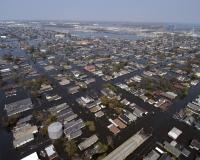
Vibrant Environment
Climate Change And Sustainability
All | Biodiversity | Climate Change and Sustainability | Environmental Justice | Governance and Rule of Law | Land Use and Natural Resources | Oceans and Coasts | Pollution Control


Part I of this four-part blog series provided an overview of local climate planning and elements common to most plans. This article distinguishes the components of a mitigation plan from those of an adaptation plan.

Local governments can play a critical role in reducing greenhouse gas (GHG) emissions and preparing their communities for projected climate change impacts. These governments are well-positioned to assess local climate hazards and risks, identify opportunities to reduce GHG emissions, and engage the community in identifying priorities. Crucially, they are the first responders to public health emergencies and extreme weather events and possess powerful tools over land use and the built environment.

Part 1 of this two-part blog series explored the history and current use of carbon, capture, and storage (CCS). Part 2 discusses the policy challenges that limit CCS use and how these policies can be improved to expand it.
The biggest question is: if CCS can reduce carbon dioxide emissions so drastically, why isn’t everyone implementing it?

Avoiding the worst effects of climate change—including drought, food insecurity and unprecedented migration—means limiting global temperature rise to 2°C (the Paris Agreement sets a more ambitious 1.5°C goal). A number of technologies are being pursued to help solve the climate crisis including carbon capture and storage (CCS).

In a recent episode of People Places Planet Podcast, Research Associate Heather Luedke spoke with John R. Nolon, land use law expert and Professor of Law at Elisabeth Haub School of Law at Pace University, to discuss the emerging crisis of “land use climate bubbles.” Land use climate bubbles, which form when property values decline due to climate change impacts, have been popping up across the United States and could lead to an economic crisis worse than the 2008 housing bubble.

The transition to a zero-carbon economy depends, we are told, on the United States’ ability to assure a supply of rare earths and minerals such as cobalt, nickel, or lithium. Dialogues surrounding critical minerals have intensified over the past decade, and the International Energy Agency suggests we are on track for either doubling or quadrupling our “overall mineral requirements for clean energy technologies by 2040.”

Part 1 of this two-part blog series provided a background on climate change and internal displacement and underscored the need to develop equitable climate programs. Part 2 provides policy recommendations for the federal government to proactively address the challenges of climate-related displacement.

Climate change-related stressors are expected to drive the displacement of an estimated 200 million people by 2050. Meeting the needs of millions of cross-border climate migrants is a pressing concern at every level of governance. Although President Joseph Biden’s Executive Order No.

With the 2021 UN Climate Change Conference (COP26) focused on pledges reducing carbon emissions 2030 and beyond, the urgency to cut emission now seems overlooked. Unfortunately, the 2020s are ground zero in our uphill battle to thwart the rise in global warming, soon enough for those pledges to be meaningful. As global warming already exceeds 1°C of the 1.5°C targeted and continues to climb, we must slow emissions growth within this decade for a reasonable chance of future success.